 Image search results - "fish" Image search results - "fish" |

Sakana-no-Furusato Bandaijima Fish market near Toki Messe. さかなのふるさと万代島
|
|

Crab
|
|

Crab
|
|
|
|
|

Salmon
|
|

Trout fishing ponds for customers in warmer months.
|
|

Koi carp fish
|
|

Riverside fishing ponds
|
|

Huge and hungry carp
|
|

Fishing ponds
|
|

Koi
|
|

Koi in Ochiai River
|
|

From July 1 to Sept. 23, Arashiyama also has ukai cormorant fishing. Buy your tickets at this booth slightly upstream from Togetsukyo Bridge.
|
|

The ukai cormorant boats operate twice each evening at 7 pm and 8 pm (6:30 pm and 7:30 pm in Sept.). ¥1,800 for adults and ¥900 for kids age 4–12.
|
|

On board a yakata-bune to view ukai cormorant fishing. Fits about 10 people.
|
|

The boats are hitched together.
|
|

Gifu is not the only place where you can see ukai cormorant fishing.
|
|

Ukai cormorant fishing on the river at Arashiyama was quite enjoyable. It's cheaper than in Gifu, and the cormorants passed by maybe 6 times.
|
|

Yakata-bune boat steerer.
|
|
|
|
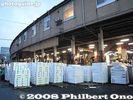
Officially called the Tokyo Metropolitan Central Wholesale Market, this sprawling complex handles mainly fish, but also fruits and vegetables. This is outside the market building.Update: Tsukiji Fish Market closed on Oct. 6, 2018 since it moved to Toyosu. These pictures were taken when toursts were still free to roam around the auction area and inner market. Now a blast from the past. Sorry you missed it.
|
|
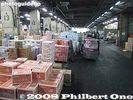
The market is near Tsukijishijō Station on the Toei Ōedo Line and Tsukiji Station on the Tokyo Metro Hibiya Line. The first subway arrives at around 5:20 am. First you walk through the fruit section..
|
|
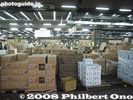
Fruit section.
|
|

Watch out for these speeding trolleys. They are almost everywhere.
|
|
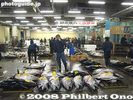
There is no map of the place so you may or may not find the tuna auctions. It's also easy to get lost in the market. This is the fresh fish tuna storage area.
|
|

Never saw this much tuna in my life.
|
|
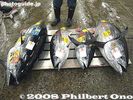
These fish can be huge, bigger and heavier than a sumo wrestler.
|
|
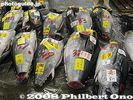
All the fish are labeled. They might indicate where the fish was caught (or raised).
|
|
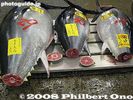
Tails are cut off to show the flesh color.
|
|
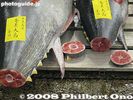
Buyers check the color of the flesh to determine how fatty the fish is.
|
|
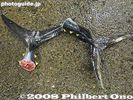
Cut-off tails
|
|
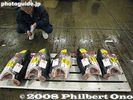
Headless tuna carcasses
|
|
|

Tuna head
|
|
|

The market building has many signs of its old age.
|
|
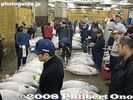
Frozen tuna auctions at Tsukiji Fish Market.
|
|
|
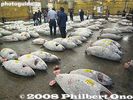
Frozen tuna anyone?
|
|
|
|
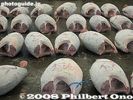
Headless frozen tuna.
|
|
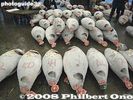
These frozen fish did not show any signs of melting. Wonder how long it takes for them to defrost.
|
|
|
|
|
|

Each fish is worth thousands or tens of thousands of US dollars.
|
|
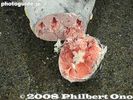
Looks good to me.
|
|
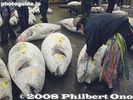
Tying a ribbon on fish.
|
|
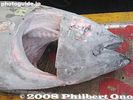
Frozen tuna head
|
|

Tuna belly, the fatty part of the fish for toro sashimi.
|
|
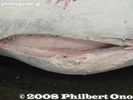
Looks yummy.
|
|
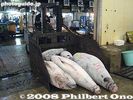
After the auctions are over, they haul out the fish using a variety methods.
|
|

Hauling these tuna on this lift looked easy.
|
|

All full and ready to go. Gee, how much is all that tuna worth??
|
|
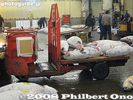
Smaller trolley for a smaller haul.
|
|
|
|

Hand-drawn cart.
|
|
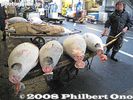
Hand-drawn cart, good for four fish.
|
|
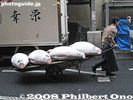
Good exercise in the morning.
|
|
|
|
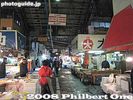
The fish is taken to the fish stalls in the market.
|
|
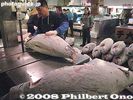
The frozen tuna is cut up into quarters lengthwise by a band saw.
|
|
|
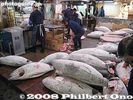
Quite a few more to cut up.
|
|
|

After the fish is cut, they shave it with an ax.
|
|

Cutting up a fresh fish. They use a long, sharp knife, and not a band saw.
|
|
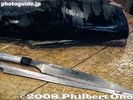
Tuna knives
|
|
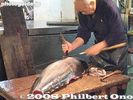
I wonder how long it takes to be able to cut up a giant tuna.
|
|
|
|
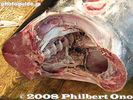
Where the head was attached.
|
|
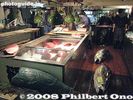
The fresh tuna is cut up into smaller blocks.
|
|

This size is easy to sell to mom and pop sushi restaurants.
|
|
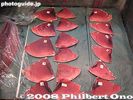
Fresh tuna
|
|
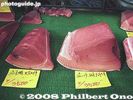
Caught in the Pacific Ocean.
|
|

The tuna flesh between the rib-like bones is also choice meat. It is scraped off with a spoon.
|
|
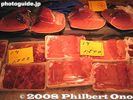
Packaged to sell.
|
|
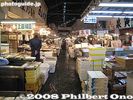
The huge fish market consists of rows and rows of fish monger stalls, divided by narrow aisles.
|
|
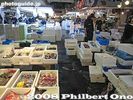
Styrofoam and plastic cartons contain all kinds of fish.
|
|
|
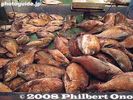
Fish waiting to be decapitated.
|
|
|
|
|

OK, which one's next?
|
|
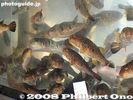
Puffer fish swim happily, ignorant of their ultimate fate.
|
|
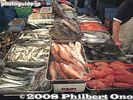
Fish and more fish...
|
|
|
|
|
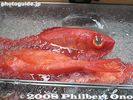
Fish in ice
|
|
|
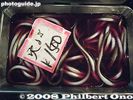
Eels
|
|
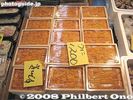
Sea urchin (uni), one of my favorites.
|
|
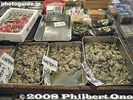
Oysters
|
|
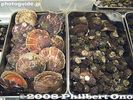
Shellfish
|
|

Sea urchins
|
|
|
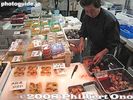
Shellfish
|
|
|
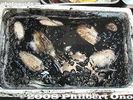
Squid in black ink
|
|

Octopi
|
|

Tako
|
|

Shrimp
|
|
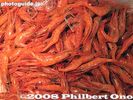
Prawns
|
|
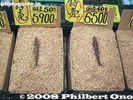
Prawns
|
|
|

Frozen crab
|
|
|
|
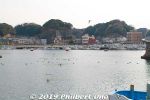
Hirakata Port is a major fishing port in Kita-Ibaraki.
|
|

Hirakata Port has a fish market that holds a fish auction in the afternoon. This is a typical wholesale fish market in Japan. Open-air, flat roof with a concrete floor next to fishing boats.
|
|
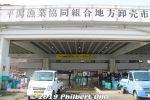
It's unlike the old Tsukiji fish market or the new Toyosu Market in Tokyo.
|
|
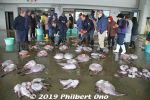
Hirakata Port's main catch is the monkfish/goosefish (あんこう), a type of anglerfish. Ibaraki Prefecture's coast is one of Japan's prime areas for monkfish. These are all monkfish being auctioned in the afternoon. 平潟港 せり見�
|
|
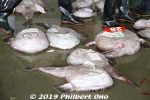
Monkfish/goosefish (あんこう), a type of anglerfish. They are most prized for their liver (ankimo), a local delicacy.
|
|

There are many species of angler fish in the world. The one caught in Japan is this one, Lophiomus setigerus.Monkfish has a big head, wide mouth, and a lure on the forehead to attract small fish. Looks kind of grotesque and lives on the ocean floor.
|
|
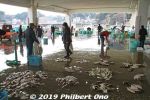
Besides monkfish, other fishes are sold at auction. This is not yet a tourist attraction since we were the only outsiders there.
|
|
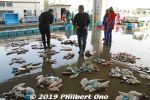
Each pile of fish is for a single bid.
|
|
|
|
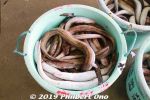
Sea eels or anago.
|
|
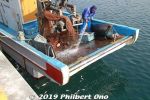
Cleaning up the fishing boat. Bycatch dumped overboard, but the birds are not picking it up.
|
|
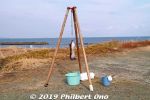
Oh look, something's hanging there...
|
|
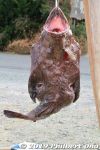
It's Kita-Ibaraki's famous fish and delicacy, monkfish, in the flesh. This one is 5 or 6 years old, weighing 12.7 kg. Only the female monkfish is eaten. The males are too small.あんこう
|
|
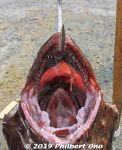
Look into the big mouth and see another set of teeth on the throat. All the teeth are pointed inward so its pray cannot escape. Like the aliens in the movie "Alien."
|
|
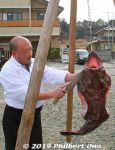
Monkfish being skinned and carved up by an expert chef. Since the monkfish is too slimy and slippery on a cutting board, it is hung like this for carving. It's a lot easier to cut up this way.He first takes off the skin (loaded with collagen).
|
|
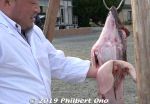
The chef is holding the liver (ankimo), the most prized part of the fish.
|
|
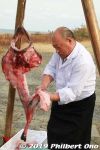
The white meat of monkfish.
|
|
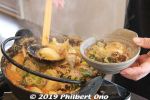
This is monkfish hot pot (dobojiru ankou-nabe) どぶ汁 with monkfish parts in a miso broth. I didn't have any problem eating it. The flavor was certainly not objectionable, it's just another kind of fish.It was already prepared for us and it wasn't the fish we saw carved.
|
|
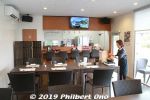
Akatsukien onsen minshuku dining room where we had monkfish hot pot. ¥14,000/night including dobujiru. 民宿 暁園
|
|
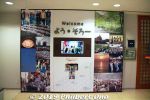
Yo-soro Fishing History Museum, 5 min. by taxi from JR Otsuko Station. Pretty large facility with local fishing-related exhibits. 北茨城市漁業歴史 資料館「よう・そろー」
|
|
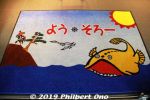
Welcome mat saying "Yo-soro" which means "Go ahead" for boat navigation.
|
|
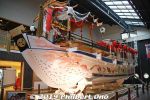
In Kita-Ibaraki, the Yo-soro Fishing History Museum's centerpiece exhibit is this wooden boat (祭事船) used in the Hitachi-Otsu Ofune Matsuri boat festival held every 5 years (常陸大津御船祭り).
|
|
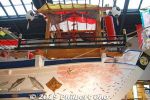
It's the city's grandest festival and very unique because this boat is pulled on city streets instead of sailing on the water.
|
|
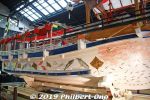
About 500 people drag this boat along a 1,200-meter route of paved streets. They lay wooden beams on the road for the boat to traverse on.
|
|

The boat, with shrine priests and musicians aboard, is rocked side to side as it is dragged on the street for several hours. This festival will be held on May 2nd–3rd, 2019. At least 160,000 spectators are expected to see it.
|
|

Short video of Hitachi-Otsu Ofune Matsuri boat festival.
|
|

The museum also has display panels showing the tsunami damage suffered by Kita-Ibaraki. Ibaraki Prefecture, being on the southern fringe of the Tohoku Region, suffered major earthquake and tsunami damage in March 2011.Kita-Ibaraki being closest to the Tohoku Region on the coast, suffered the most in Ibaraki Prefecture. The flat sandy beaches were overcome by the tsunami (second wave around 5 meters high) that caused much damage to Kita-Ibaraki. This is the Hirakata area after the tsunami. Besides major damage along the coast, the interior areas had numerous landslides, collapsed walls, and damaged roads due to the quake.
|
|

Ten people in Kita-Ibaraki died directly or indirectly due to the tsunami/earthquake and 186 injured. Over 8,000 homes in Kita-Ibaraki were damaged and up to 5,000 people had to evacuate to emergency shelters.These numbers pale in comparison to the three Tohoku prefectures, so Ibaraki doesn't get much attention with regard to 3-11, although the Emperor and Empress did visit Kita-Ibaraki in late April 2011.
|
|
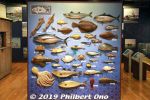
Display of all the fishes caught in Kita-Ibaraki.
|
|
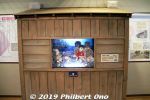
Yo-soro Museum also has this kami-shibai storytelling room. Story about British whalers who landed on Otsuhama beach in Kita-Ibaraki in May 1824 in search of food and water.It was during the time Japan largely prohibited contact with foreigners. By the 1800s, whaling ships from the West were frequently seen off the coast of Japan. In May 1824, multiple British whaling ships appeared off the coast of Kita-Ibaraki.
|
|
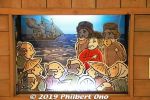
The crew suffered from scurvy due to the lack of vitamin C. They needed water and vegetables so 12 British whalers landed on Otsuhama beach in Kita-Ibaraki. They were willing to barter guns, spears, gold, etc., as payment. (大津浜事件)
|
|
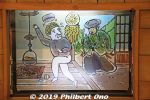
However, the 12 whalers were instead held captive by the local samurai. They were tied to plum trees or confined to caves. More British ships arrived seeking the release of the prisoners.Also, the Mito Clan also brought in neighboring clans like the Taira Clan as reinforcement for a potential battle. Cannons were pointed at each other, but a conflict was averted by giving the whalers the water and food that sent them along their way away from Japan. In return, the whalers gave guns, spears, felt, gold, and silver as payment and had to promise not to approach Japan again.
|
|

Omi-cho Market entrance. 近江町市場
|
|

Omi-cho Market is full of seafood vendors.
|
|

Omi-cho Market crab vendor.
|
|

Omi-cho Market
|
|

Omi-cho Market
|
|
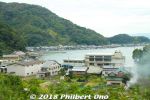
On the east coast of Tango Peninsula in northern Kyoto Prefecture is Ine, a picturesque fishing village right on the water's edge. Unique for the built-in funaya "boat garages" (舟屋) where waterfront homes keep a boat next to the water. This village is designated as a National Important Traditional Townscape Preservation District (重要伝統的建造物 群保存地区) and Japan's first fishing village to be so designated.("Funaya" means boat house.)
|
|

Ine is kind of out of the way to visit, but well worth the trip.
|
|
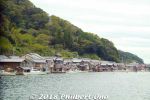
Ine has been used as a backdrop in Japanese movies (like Tora-san in movie No. 29 and Tsuribaka Nisshi in movie No. 5).
|
|
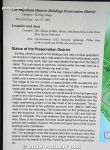
About Ine's Important Traditional Townscape Preservation District.
|
|
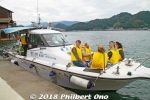
A great way to see Ine is by boat (called "sea taxi"). Small boats offer 30-min tours for only ¥1,000 per person. This boat was the "Kameshima Maru" (亀島丸) operated by Toshikazu Yamada. He pointed out the boat houses and locationThere's no cruise schedule so you can just call and set a time for a cruise. There must be at least two people for a cruise to depart. http://kameshimamaru.server-shared.com/index.html
|
|
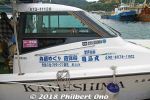
Phone No. for Mr. Yamada's Kameshima Maru boat cruises in Ine.
|
|
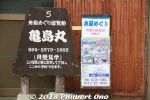
Phone No. for Mr. Yamada's Kameshima Maru boat cruises in Ine. This is at the boat dock.Map (Kameshima Maru boat dock): https://goo.gl/maps/9zmSW4Nun4P2
|
|

Seagulls expect to be fed by boat tourists. We even got free bird food. But I feared the droppings on me or my cameras. Luckily I came out clean.
|
|
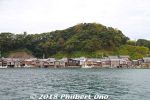
Ine in northern Kyoto Prefecture has 230 funaya boat houses on the waterfront stretching for about 5 km.
|
|
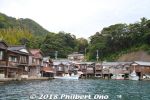
Some of the funaya offer lodging where you can stay above the boat garage. They get booked up quickly though. They let you go fishing by boat or from shore.
|
|
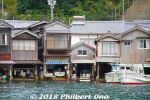
You may think these homes in Ine are sitting ducks for high waves, typhoons, high tides, etc. But they are in a sheltered bay facing south, away from the Sea of Japan. Mountains shield the bay on three sides and a small island (Aoshima) on the bay's entrance acts like a breakwater. Ine Bay is largely untouched by the rough seas of the Sea of Japan and the water is very calm. Also, the ocean tide varies by only 50 cm at most. See Ine's location here: https://goo.gl/maps/sXVERESwvMT2
|
|
|
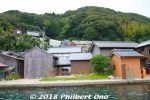
This used to be a cruise boat dock. Used in a Tora-san movie with Ishida Ayumi.
|
|
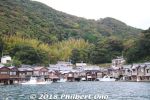
The Ine waterfront has looked like this since the 1930s when they reclaimed some of the coastline and fishermen rebuilt their homes right over the water.
|
|
|
|
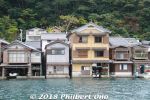
These boat houses are usually used as a second house for retired grandparents or for a young married couple who want some privacy (especially at night). Or it can be used as a workplace, a guesthouse, or paid lodging.
|
|
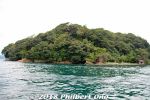
Aoshima is the small island at the Ine Bay's entrance acting as a breakwater. There's an Ebisu Shrine on the island. Only fishermen are allowed on the island.
|
|
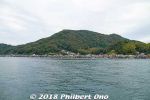
Ine from afar.
|
|
|
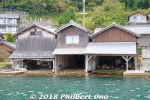
These funaya are the oldest in Ine, dating back to the Edo Period.
|
|
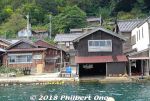
This boat house was used in Tora-san movie No. 29 with Ishida Ayumi and Atsumi Kiyoshi. Looks the same.
|
|
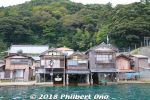
The 30-min. boat cruise gave us our fill of many photos of these funaya.
|
|
|
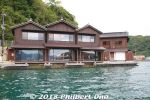
A few new buildings have also been built for tourists.
|
|
|
|
|
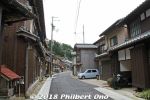
Coastal road in Ine.
|
|
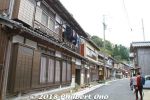
We also had a guided walking tour of Ine village. Behind the funaya boat houses is this narrow coastal road and another row of homes across the road on the left at the foot of the hills. The homes along the left are the main homes where the fishermen's family live. And their funaya boat houses are right across the road on the right.
|
|
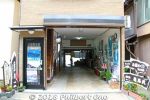
This is the boathouse of Mr. and Mrs. Toshikazu Yamada (山田 敏和), a very friendly fishermen couple who runs Ine boat cruises and work as fishermen.This is what a funaya boat house looks like from the road. First there is a normal car garage. The boat house is not that big.
|
|
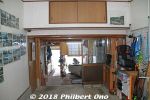
Enter the car garage and walk toward the back to see another room.
|
|
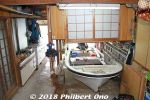
In the back of the car garage is the boat garage on the water's edge. The small fishing boat is hoisted and secured by a power winch. Above the boat is just storage space (not another room). The family uses the boat to catch fish for themselves.
|
|
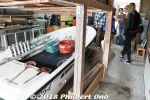
These boat garages were originally built to protect the boat from the elements. In the old days, boats were made of wood. They did not have a waterproof deck like modern boats do today. So the boat garage protected the boat from rain, etc.
|
|
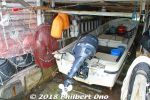
The boat was also hoisted to dry in the garage. Since seawater tended to rot wood, drying the boat when not in use would make the boat last longer.
|
|
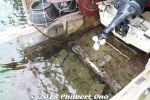
I asked about the recent typhoons that hit this area. Mrs. Yamada said that the secured boat shook a lot, but no damage.
|
|
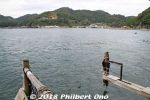
Looking out from the boat garage.
|
|
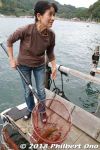
Mrs. Yamada also keeps fish in a net under their small dock. I asked what kind of fish, and she caught two to show us.
|
|

They were Redspotted Grouper (アコウ、キジハタ), a valuable fish delicious as sashimi. They are feeding these fish until they get big enough for eating.
|
|
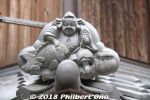
Roof tile ornament of Ebisu, god of fishing.
|
|
|

Small waterfront Ineura Park (伊根浦公園) on Ine Bay.
|
|
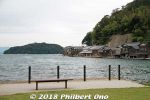
Ineura Park (伊根浦公園) on Ine Bay.
|
|
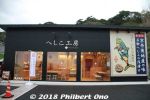
Tasted more local food here at Heshiko Kobo Hisami (へしこ工房 Hisami), a restaurant/shop in Kyotango.Map: https://goo.gl/maps/Jq7NoojH59s
http://www.hisami-kasade.com/page/shop.php#heshiko
|
|
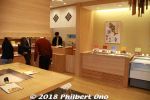
Inside Heshiko Kobo Hisami.
|
|
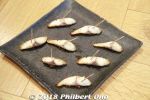
A local fish delicacy called "heshiko." Heshiko is made in this coastal region of Kyoto and Fukui Prefectures. It uses mackerel (saba), sardines (iwashi), or Pacific saury (sanma) that are salted and then fermented in rice bran (nuka). For heshiko, mackerel is most popular and the process takes two years. It is a traditional way to preserve fish for later consumption without refrigeration. It was a common (and cheap) food for the masses, but now it's a delicacy.
This restaurant believes too much salt is not so healthy, so they take only two weeks to salt and ferment the fish. This method is called asazuke (浅漬け) which means "lightly pickled." We sampled the mackerel prepared this way (and grilled), but I thought it was very salty already and hardly any taste of fermentation.
|
|
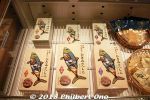
Heshiko for sale.
|
|
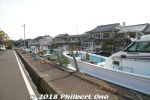
Yoshihara Inlet is a picturesque waterfront fishing neighborhood with boats moored right outside. Fishing village since the Edo Period. Located on the north end of Isazu River (伊佐津川). "Yoshihara" means reed fields, so this area used to have reed beds on marshy land. About 20-min. walk from JR Nishi-Maizuru Station (JR Maizuru Line). Map here
|
|
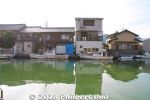
The homes used to have built-in boat garages like at Ine, but they were abolished and the boats are moored right in front instead.
|
|
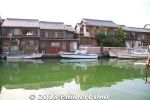
You can just walk along the inlet (be careful not to trip over the boat lines and ropes).
|
|
|
|
|
|
|
|
|
|
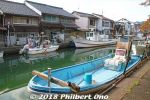
Yoshihara Inlet
|
|
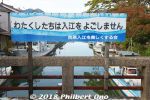
Walk until this bridge going over the inlet. Banner says, "We won't pollute the inlet."
|
|
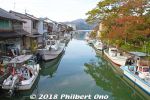
Get some good shots of the inlet from the bridge.
|
|
|
|
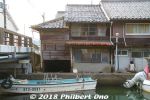
Here's one house that used to have a boat garage connected to the water.
|
|
|
|
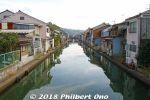
Beyond the bridge, the inlet has no boats.
|
|
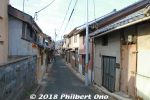
This is the road behind the homes along the inlet.
|
|
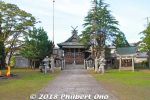
Next to the bridge is this local Shinto shrine named Minazuki Jinja dedicated to Tsukuyomi (月夜見命), the Moon deity and younger brother of Sun Goddess Amaterasu. 水無月神社
|
|
|
|

Definitions of endemic, native, endangered, and invasive species.Native species (在来種)
Naturally inhabits Lake Biwa or Shiga and not introduced by man. May also inhabit places outside Shiga.
Endemic species (固有種・亜種)
Native species found only in Lake Biwa or Shiga.
Endangered species (絶滅危惧種)
Those facing a high risk of extinction in the wild.
Invasive species (侵略的外来種)
Introduced by man and harms the native species, environment, and local ecosystem.
|
|

Fish in Reed Beds & Attached Lakes 内湖・ヨシ原にすむ魚 - Reeds are a haven for carps (wataka, ginbuna), bitterlings, gudgeons, and mussels. Invasive species (black bass, bluegill) dominate such habitats today.
|
|
|

Wataka (ワタカ) Ischikauia steenackeri - Endangered endemic species, herbivorous fish.
|
|

Mussel
|
|

Reeds are essential
|
|

Aquarium tunnel showing rocky habitat.
|
|
|
|

Nigorobuna carp (ニゴロブナ 似五郎鮒) - Endangered endemic species, famous for funazushi.
|
|

Gengorobuna carp (ゲンゴロウブナ) - Endangered endemic species
|
|

Lake Biwa Giant Catfish is shy and often hides in its shelter.
|
|

On another day, we were able to see the two Lake Biwa Giant Catfish out in the open. It is nocturnal, and this tank simulates night time while the aquarium is open during the day. The lake's largest endemic species and Japan's largest catfish. �
|
|

Lake Biwa Giant Catfish is the lake's largest endemic species (max. 1.2 meter long), dubbed the King of Lake Biwa.
|
|

The tank simulates night time since the Lake Biwa Giant Catfish is nocturnal.
|
|

Ko-Ayu (コアユ) Native species, popular food fish. Ko-ayu is the small variety of ayu (not baby ayu) commonly eaten as tsukudani (佃煮) or tempura. Adult ko-ayu retain their small size.
|
|

Tempura ko-ayu sweetfish do not grow as large as the ayu sweetfish which grow big in rivers. Ko-ayu remain in the lake and feed on plankton. Such an environment prevents them from getting larger.
|
|

Biwa trout (ビワマス) - Endangered endemic species
|
|

Biwa trout/salmon - Endemic to Lake Biwa and lives in deep, cold (15˚C), pelagic waters. These are juvenile fish. Delicious!
|
|

Lake Biwa Littoral Zone 琵琶湖の岸辺の生き物 - Many small organisms live amid aquatic plants near the shore.
|
|

Numa-ebi shrimp (ヌマエビ), Native species
|
|

Sugo-Moroko gudgeon (スゴモロコ) - Endangered endemic species
|
|

Biwa-kogata-sujishima spiny loach (ビワコガタスジシマドジョウ) - Endangered endemic species
|
|

Biwa-Yoshinobori goby (ビワヨシノボリ) - Endemic species
|
|

Donko sleeper (ドンコ) - Native species endemic to Japan.
|
|

Hon-moroko (honmoroko) gudgeon (ホンモロコ) - Endangered endemic species, but it has been recovering in numbers during the 2020s.
|
|

Utsusemi-kajika sculpin (ウツセミカジカ) - Endangered endemic species
|
|

Utsusemi-kajika sculpin (ウツセミカジカ) - Endangered endemic species
|
|

Abura-higai gudgeon (アブラヒガイ) - Endangered endemic species
|
|

Biwa-higai gudgeon (ビワヒガイ) - Endemic species
|
|

Fish with Unusual Traits 面白い習性の魚 - Gigi talking catfish.
|
|

"Gigi" talking catfish (ギギ) Pelteobagrus nudiceps - Native species
|
|

Tanago bitterling and clam (タナゴ) - Endangered native species, endemic to Japan, lays eggs in living clams.
|
|

Ginbuna carp (ギンブナ) - Native species, reproduces without males.
|
|

Invasive Species 外国からきた魚 - The aquarium has a number of tanks showing invasive species like this Red-eared slider/terrapin (ミシシッピアカミミガメ).Invasive species, popular pet, outcompetes native turtles for physical space.
|
|

Northern snakehead (カムルチー) - Invasive species, eats aquatic insects, mollusks, and carp.
|
|

Red swamp crayfish (アメリカザリガニ) - Invasive species, destroys water plants, outcompetes others for food.
|
|

Black bass (Largemouth bass) are the worst invasive species in Lake Biwa. (ブラックバス・オオクチバス)
|
|

Largemouth bass (black bass) and bluegill are Lake Biwa's worst invasive species. They eat eggs and fry of native fish, crustaceans, and insects.
|
|

Bluegill was brought to Japan in 1960 as a food fish by then Crown Prince Akihito who received it as a gift from Chicago, IL. In 1963, the Fisheries Agency sent bluegill to Lake Biwa. Ten years later, bluegill had spread all over the lake. In 2007 in Shiga, Emperor Akihito expressed regret over bringing the bluegill.
|
|
|
|